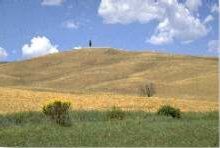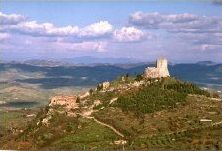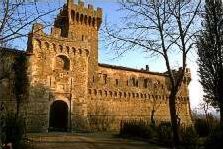ARTISTIC, NATURAL AND CULTURAL PARK
OF THE VAL D'ORCIA
The Val d'Orcia is situated
far from the din of modern
life, fortunate to be distant
from fast highway and
major traffic junctions.
(...)
(Foto)
Val d'Orcia is not
merely a geographical
space naturally favoured
by its history
neither is it a context
then that can be defined
poetically by a series
of images. (...)
(Foto)
The people of the past
always sought in this land
a vital relationship with
nature, a relationship at
times consciously strong,
at times unconsciously sweet.
(...)
(Foto)
No matter from what side
you look at it, the
scenary of the Val d'Orcia
revolves harmoniously
around its unique landscape
and then suddenly rushes
towards its great maternal
source of irrigation:
Monte Amiata
(Foto)
The vegetation, which
everywere seems to grow
thicker at the tops of the
hills and to encircle
the ditches in a desperate
assault, creates unprendictable
depths and symbols (...)
(Foto)
Morphologically the Val
d'Orcia is a vast
spur of clay (...)
The stretches of barren
clay, known as biancane
still mark the landscape
of Val d'Orcia in a unique way (...)
Calanchi, instead are found
where the Pliocene clay,
is covered by a layer of sand favouring a slope which lets the water run off.(...)
(Foto)
In the Foce area (road to Chianciano), on the slopes facing south where there
is no vegetation, the climatic conditions favour the formation of morphologies similar
to those found in arid climates. (...)
In our era, the clay landscapes were made famous by painters like Dario Nero, and by the
Val d'0rcia painters Aleardo Paolucci and Aleardo Monaci. (...)
But the Val d'Orcia is not merely clay.
To the
north-west
of Bagno Vignoni lies a beautiful gorge of bare rock,
woods
and marvellous Mediterranean brush
stretching tonwards the sea
after having dashed against
the ocean of the vineyards
of Montalcino (...)
Between Castiglione d'Orcia, San Quirico and Montalcino, the territory of Val d'Orcia Park
is mainly covered by a widespread mantle of woodland (...)
(Foto)
In this vast territory, enlivened both by the rural scenary abd by the most interesting
naturalistic features, visitors and nature lovers can find an environment that human
presence has altered without overwhelming it.
The Val d'Orcia is situated
far from the din of modern life, fortunate to be distant from fast highway and major traffic
junctions.
The absence of industrial development and the unbroken link of its people with the land
and with traditional crafts have protected the humanity-environment relationship and
raised it to a level of dignity rarely seen elsewhere.
Val d'Orcia is not merely
a geographical space naturally favoured by its history, neither is it a context then that can be
defined poetically by a series of images.
More than anything else, it is a kind of ecosystem of social, geographic and cultural relationships
which needs to be protected and understood in all its complexity.
The people of the past
always sought in this land a vital relationship with nature, a relationship at times consciously
strong, at times unconsciously sweet. Today, the traces of these relationship enable us to
interpret the scene in retrospect and to draw close to those older visions that fascinated
painters, artists and travellers.
The vegetation, which everywere
seems to grow thicker at the tops of the hills and to encircle the ditches in a desperate assault,
creates unprendictable depths and symbols and then, suddenly unexpectedly, forms frail barriers,
cadenced signals, frames. High up, were the line of hills brakes against the abrupt harsh and
sharp outlines of the rocks, the vegetation suddenly thickens and then thins out in to the soft
lines of the vineyards or the patterns of the vegetable gardens.
Morphologically the Val d'Orcia is
a vast spur of clay which still has banks of tuff with soft, golden sandstone in the higher places;
it stretches without interruption to Mounts Amiata and Cetona, against which breaks the "deadtide"
Luzi wrote. These crete (clay landscapes), which once frightened those who travelled the roman road
through them, still retain their ancient beauty in many places but there are vast areas where the
inexorable advance of modernity into the country side has changed their apparance. That is why it
is now the task of the inhabitants of Val d'Orcia to protect them as a great treasure which left
by nature to everybody which no ownership as the right to destroy.
The stretches of barren clay, known as biancane still mark the landscape of Val d'0rcia
in a unique way and their effect on it is both morphological and poetic at the same time,
so much so that some Municipalities have decided to protect them by imposing landscaping
regulations.
But there is still a long way to go before the biancane can be saved and a courageous breakthrough
in awareness is called for. The Natural and Art Park of the val d'Orcia which is being
created will make a great contribution to this.
The calanchi (erosion furrows), the biancane and the mammelloni (knolls), which can
still be seen in the localities of Casa a Tuoma (Pienza), Ripalta (S.Quirico), Lucciolabella
(Pienza), Beccanello and Torre Tarugi (Pienza) and Contignano (Radicofani)are the result
of the perennial erosive action along elevations and depressions caused by the constant
flow of rain water.
There is a vast amount of Scientific literature explaining how biancane tend to form
where the clay is less plastic and liquid.
Calanchi, instead are found where
the Pliocene clay is covered by a layer of sand favouring a slope which lets the water run off.
The process of ageing and formation of new calanchi is affected by phenomena of stripping of
the eart. This given the crete that appearance of a lunar landscape which celebrated writers
of the past like Dickens, Hawthorne or De Sade, who travelled through the Val d'Orcia,
found either astonishing or terrifying. In this connection the calanchi
most often mentioned in travel literature are those of Radicofani, a territory where
neo-tectonic folds caused linear erosion processes of which the calanchi are the direct
result.
In the Foce area
(road to Chianciano), on the slopes facing south where there
is no vegetation, the climatic conditions favour the formation of morphologies similar
to those found in arid climates.
In Val d'0rcia, where there are many types of microclimate, conditions are extremely
favourable to the biodiversity of living creatures. It is necessary to understand how
valuable this climatic rarity is in order to adapt suitable environmental protection
measures.
In our era, the clay landscapes
were made famous by painters like Dario Nero, and by the
Val d'0rcia painters Aleardo Paolucci and Aleardo Monaci. Mario Luzi's poetry gives a
very evocative idea of the crete lying between Val d'0rcia and Mount Amiata.
These have also been filmed by cinema and TV cameras in the production of important works.
But the Val d'Orcia is not merely clay. To the north-west of Bagno Vignoni lies a beautiful
gorge of bare rock, woods and marvellous Mediterranean brush stretching tonwards the sea,
after having dashed against the ocean of the vineyards of Montalcino. If you travel up the
slopes of Mount Amiata you come, in the municipality of Castiglione d'Orcia, to a mountain
forest which, as you go higher, changes from Mediterranean brush into chestnut and beech
trees. The Scarcera and Abetina del Vivo biotopes are of particular naturalistic value.
In Scarceta, in the municipality of Castiglione d'Orcia, an ilex grove of great value and
great beauty survives on the hill that slope down towards the Orcia. This type of wood lives
on a stony substratum, well drained and sunny, and it can be crossed by following the path
signposted by the Municipality of Castiglione. Abetina del Vivo, a remnant of Amiata's primary
forest, is close to the Vivo d'Orcia health resort, an old town situated below the famous spings.
Between Castiglione d'Orcia, San Quirico and Montalcino, the territory of Val d'Orcia Park
is mainly covered by a widespread mantle of woodland. The dominant species are the ilex (Quercus ilex)
the pubescent oak (quercus pubescens), the cerris (quercus cerris) or the common oak (quercus robur)
which constitute a forest covering which becames thichers as one approaches the interior of the Maremma.
here every attempt by humans to establish a proper relationship with nature is destined to succeed.
Here both animal an dvegetable species can be protected and helped to survive by following the
logic of biodiversity and by guarateeing natural ecological and evolutionary processes.
Move
the mouse on
(...) for more text
Clic on
(Foto) for the photos








